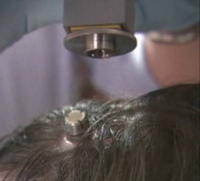
Brain-Computer Interfaces
For most of us, this is probably one of the most devastating and terrifying scenes that we can imagine. Unfortunately, there are persons for whom it is tragic reality: so-called “locked-in” patients. Because of a stroke, traumatic brain injury, cerebral palsy or a degenerative neurological disease such as amyotrophic lateral sclerosis, their entire motor system is paralyzed. These patients are fully conscious and alert, but are unable to use their muscles; they are therefore unable to communicate their needs, wishes and emotions. In these patients a healthy brain is actually locked into a paralyzed body.
There is no cure, and the cause of amyotrophic lateral sclerosis, one of the major causes of locked-in syndrome, is still unknown. In this neurological disease, the motoneurons of the central and peripheral nervous systems gradually die off. Usually paralysis begins in the lower extremities and moves on to the hands and arms, finally paralyzing the muscles responsible for breathing and swallowing. At this stage, patients can only survive if they chose artificial ventilation.
For locked-in patients, the only ray of hope is currently the development of brain-computer interfaces (BCI), a direct communication pathway between the brain and an external device that records neural processes. To a certain extent, BCI can be created with non-invasive techniques.
EEG recordings are the most thoroughly studied potential interface and have the advantage of excellent temporal resolution, ease of use and portability. Niels Birbaumer at the University of Tübingen began to use EEG recordings of slow cortical brain potentials in experiments in the mid-1990s. He was able to train paralyzed patients to use their brain waves to control a computer cursor and communicate by clicking on pictures on a monitor.
At about the same time the first neuroprostheses were implanted in patients. See a documentary by the American news channel CBS about the locked-in patient Cathy Hutchinson, who was one of the first persons to have a direct connection between her brain and a computer implanted: “Cathys Brain Power”.
Presently, scientists are using primates and rats to study how BCI might be used to partially replace a patient’s muscles. The nerve impulses from the motor center of the brain are recorded and transmitted to an external device, which the patients are thus able to control with their thoughts. Thanks to these animal experiments, locked-in patients, paralytics and amputees may one day be able to use a thought-controlled robotic arm to raise a cup to their mouths – a major improvement in quality of life.
In order to improve BCI, we need a more profound understanding of the neural code, and laboratory animals are indispensable in this research.
In order to improve BCI, we need a more profound understanding of the neural code, and laboratory animals are indispensable in this research.






